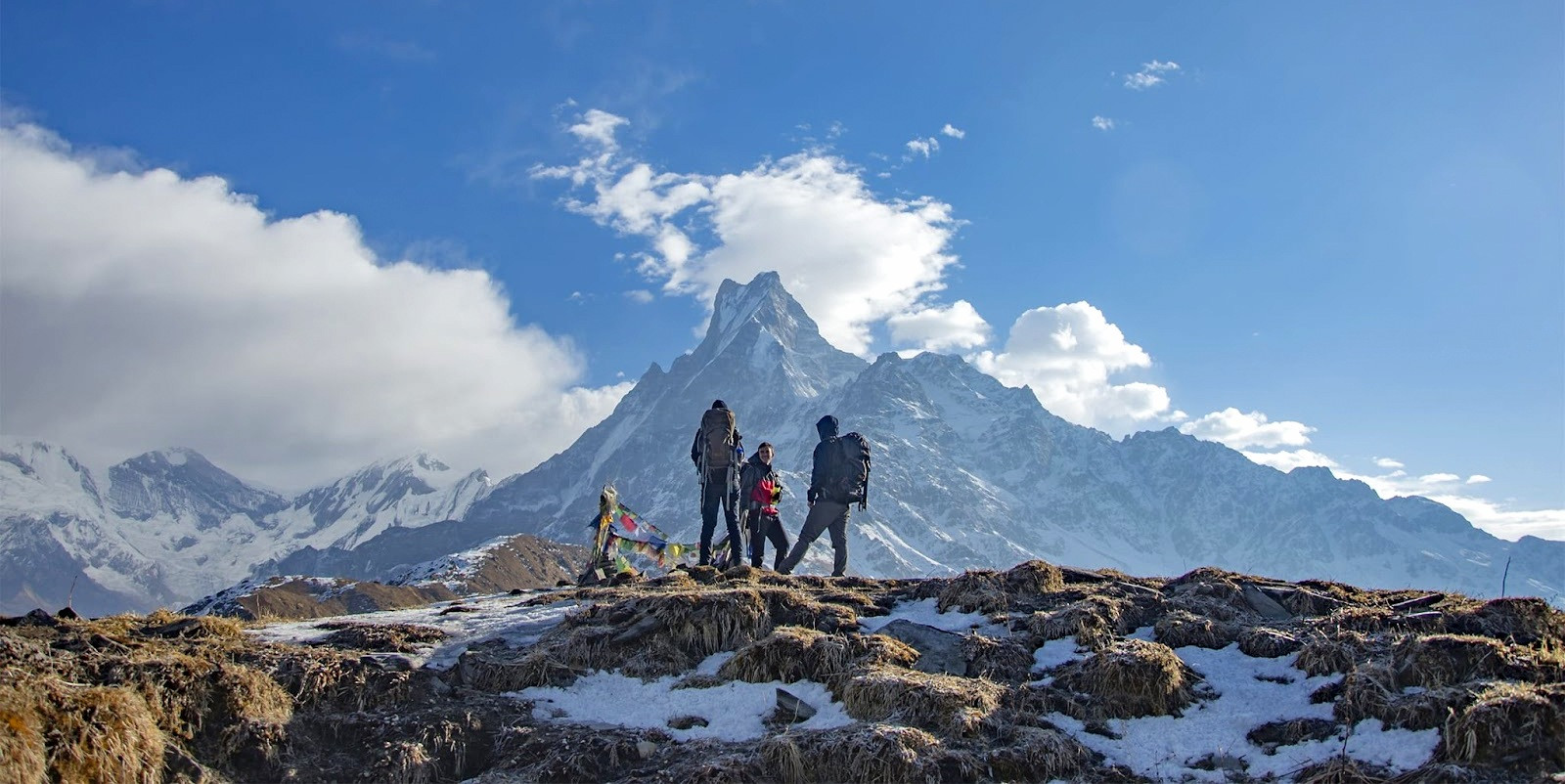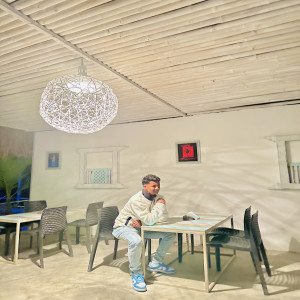Everest Base Camp Trek
The Everest Base Camp Trek is one of the most iconic and exhilarating journeys for trekkers worldwide. Situated in the heart of the Nepalese Himalayas, it takes adventurers to the base of Mount Everest, known locally as Sagarmatha. Here’s a detailed look at the trek, its route, and what trekkers can expect during this incredible adventure.
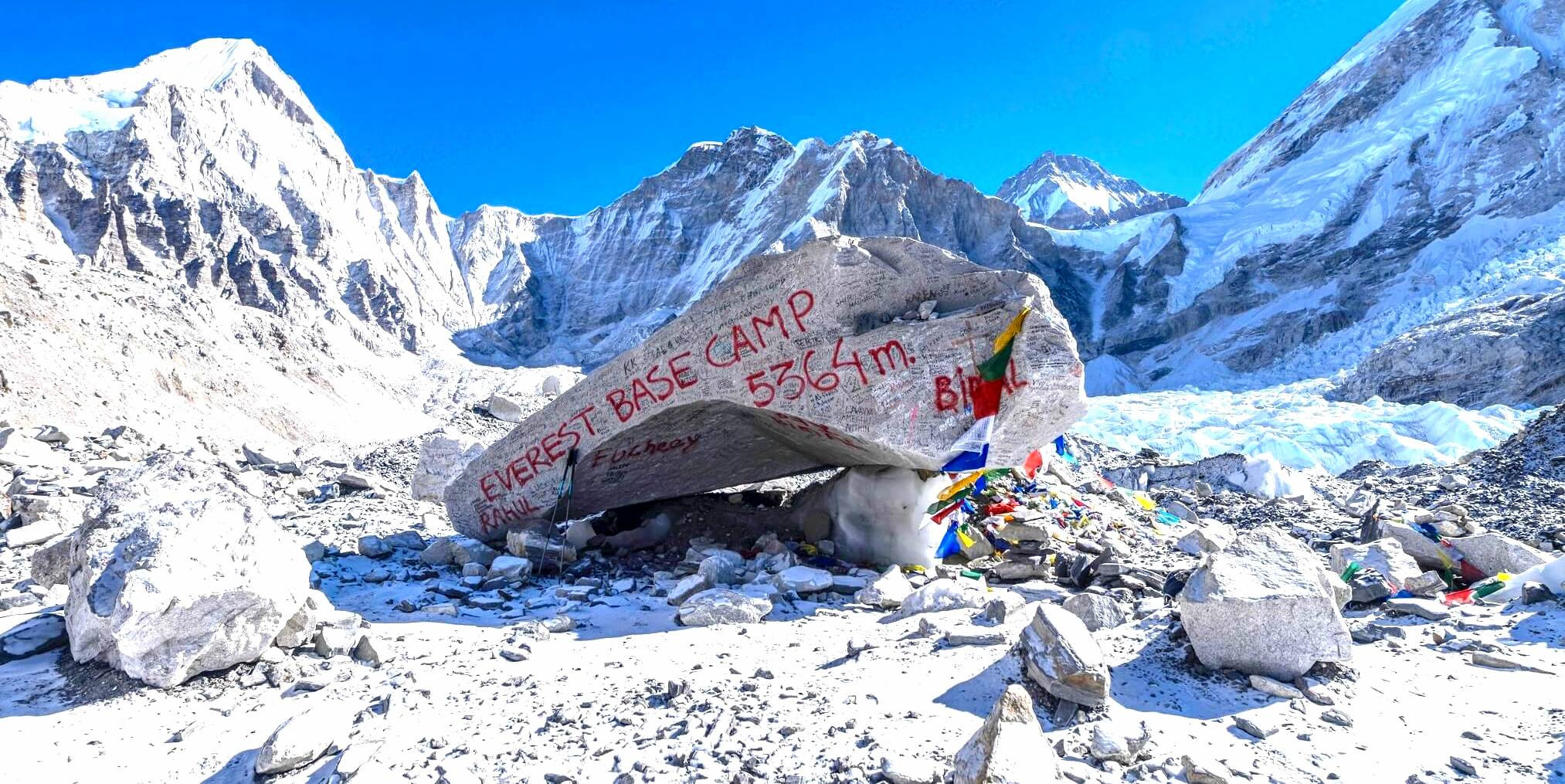
Overview
-
Duration: Typically 12 to 14 days
-
Starting Point: Lukla, accessible via a short flight from Kathmandu
-
Ending Point: Everest Base Camp, with a return to Lukla
-
Difficulty: Moderate to challenging
-
Best Season: March to May and September to November
Route: The trek starts in the small mountain town of Lukla. From there, it heads through the Sagarmatha National Park, a UNESCO World Heritage Site, traversing lush forests, Sherpa villages, and glacial rivers. Key stops include Namche Bazaar, the bustling hub of the Khumbu region; Tengboche, known for its monastery; Dingboche, a picturesque village with stunning views; and Gorak Shep, the final stop before reaching the base camp.
Highlights
-
Namche Bazaar: A vibrant town filled with cafes, shops, and stunning views of the Himalayas. It serves as a crucial acclimatization stop.
-
Tengboche Monastery: The spiritual center of the Khumbu region, offering panoramic views of Everest, Ama Dablam, and other peaks.
-
Kala Patthar: Although not on the direct route to Everest Base Camp, many trekkers make the climb to this viewpoint to get the best view of Everest’s summit.
-
Everest Base Camp: Standing at the base of the world's tallest mountain provides a profound sense of accomplishment and awe.
The Everest Base Camp Trek is not just about reaching a physical location; it's a journey into the heart of the Himalayas, filled with breathtaking landscapes, rich cultural encounters, and personal triumphs. This trek remains a bucket-list adventure for many and continues to draw thousands of trekkers each year.
Annapurna Circuit Trek
The Annapurna Circuit Trek is a world-renowned trek that circles the Annapurna massif in Nepal, offering a unique blend of breathtaking natural beauty, diverse cultural experiences, and challenging mountain terrain. This trek is known for its varying landscapes, from lush subtropical forests and paddy fields to high-altitude plateaus and stark, arid peaks.
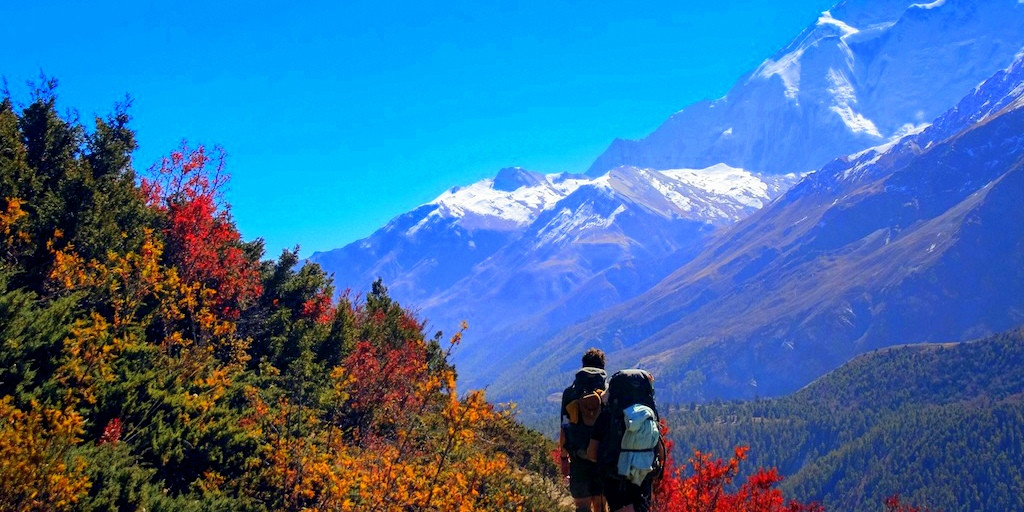
Overview
-
Duration: Typically 12 to 21 days, depending on the chosen route and pace
-
Starting Point: Besisahar or Bhulbhule in the Marsyangdi River valley
-
Ending Point: Nayapul or Jomsom, with a flight back from Jomsom to Pokhara as an option
-
Difficulty: Moderate to challenging
-
Best Season: March to May and September to November, with autumn being especially popular due to stable weather and clear skies
Route: The trek starts in the lush valleys of the Marsyangdi River, gradually ascending through diverse ethnic communities, and offers stunning views of the Himalayas including Manaslu, Langtang Himal, Annapurna II, and Annapurna IV. Important stops along the route include Manang, a village that offers crucial acclimatization opportunities, and the Thorong La Pass, which at 5,416 meters (17,769 feet) is the highest and most challenging part of the trek. After crossing the pass, the descent leads to the sacred site of Muktinath, an important pilgrimage site for both Hindus and Buddhists, before concluding in the Kali Gandaki Gorge, the deepest gorge in the world.
Highlights
-
Manang Village: A culturally rich village where trekkers often take an extra day to acclimatize, exploring the local culture and natural beauty.
-
Thorong La Pass: The highest point on the trek, offering a physically challenging but rewarding experience with panoramic views of the Annapurna range.
-
Muktinath Temple: A sacred site revered by both Hindus and Buddhists, providing a unique spiritual and cultural experience.
-
Tatopani: Known for its hot springs, a perfect spot for relaxation after the strenuous days of trekking.
The Annapurna Circuit Trek remains a compelling challenge for adventurers worldwide, offering an unforgettable journey through some of the most stunning scenery on the planet. It not only tests your physical limits but also immerses you in the deep cultural heritage of Nepal’s mountain communities.
Langtang Valley Trek
The Langtang Valley Trek is a captivating journey through the Langtang National Park in Nepal, located north of Kathmandu. This trek offers a blend of stunning landscapes, traditional Tamang culture, and easier access compared to some of Nepal's other high-altitude treks. It's an excellent option for those looking to experience the Himalayas without the crowds typical of more frequented routes like Everest Base Camp or the Annapurna Circuit.
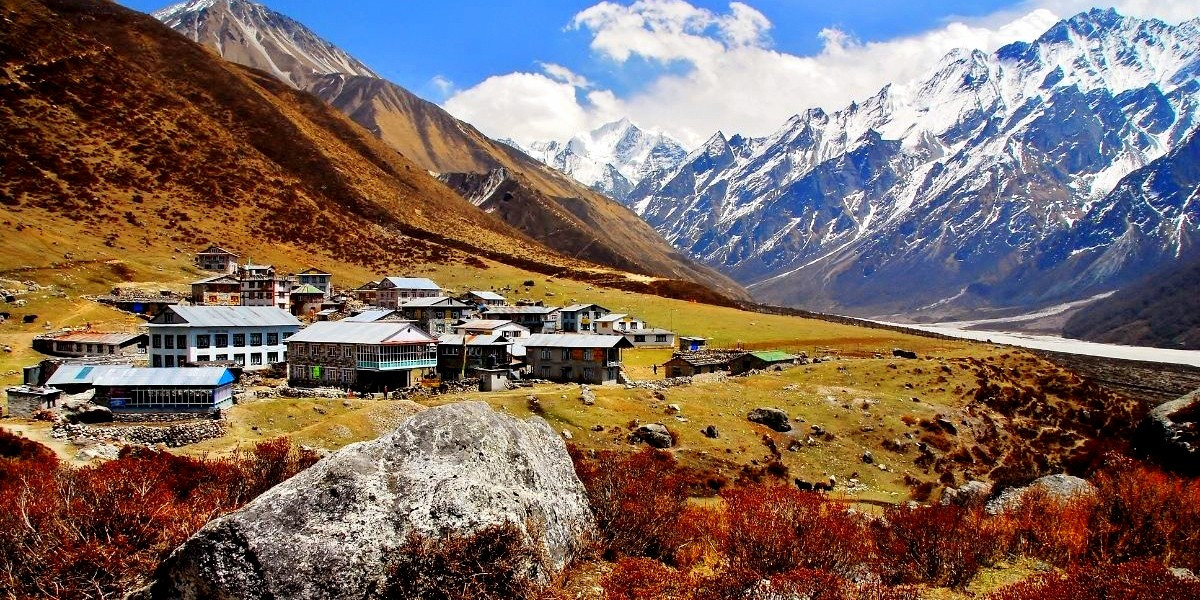
Overview
-
Duration: Typically 7 to 9 days
-
Starting Point: Syabrubesi, a few hours' drive from Kathmandu
-
Ending Point: Syabrubesi
-
Difficulty: Moderate
-
Best Season: March to May and September to November, with the autumn months providing particularly clear weather and excellent visibility
Route: The trek begins at Syabrubesi, ascending through dense forests and traditional ethnic Tamang villages. The trail follows the Langtang River and passes through oak and rhododendron forests before reaching the open valley at Langtang village, which was heavily affected by the 2015 earthquake but has been rebuilt. As trekkers move towards Kyanjin Gompa, the highest point of the trek, they find themselves surrounded by high peaks and have the opportunity to explore ancient monasteries and experience local cheese production.
Highlights
-
Kyanjin Gompa: Situated at an altitude of 3,870 meters (12,697 feet), it is a spiritual site surrounded by dramatic high peaks, with opportunities for short hikes to viewpoints like Kyanjin Ri or Tserko Ri for panoramic views of the Langtang range.
-
Langtang Village: Offers a poignant glimpse into the resilience of local communities as they rebuild after the devastating earthquake.
-
Local Culture: The trek goes through several Tamang villages where trekkers can experience firsthand the unique culture and lifestyle of the Himalayan people.
-
Flora and Fauna: The region is home to beautiful rhododendron forests and wildlife like the red panda and snow leopards, especially visible during the spring months.
The Langtang Valley Trek not only challenges trekkers physically but also offers a rich tapestry of cultural insights, making it a deeply rewarding experience for those who embark on its path. It’s an ideal trek for those wanting to experience the beauty and hospitality of the Himalayas in a more tranquil setting.
Manaslu Circuit Trek
The Manaslu Circuit Trek is a stunning journey around the world's eighth-highest mountain, Mount Manaslu, standing at 8,163 meters (26,781 feet). Known for its remoteness and beauty, it offers trekkers a less crowded alternative to the more popular Everest Base Camp and Annapurna Circuit treks. This trek is a true hidden gem that provides an authentic insight into the rural Himalayan lifestyle and the region's natural beauty.
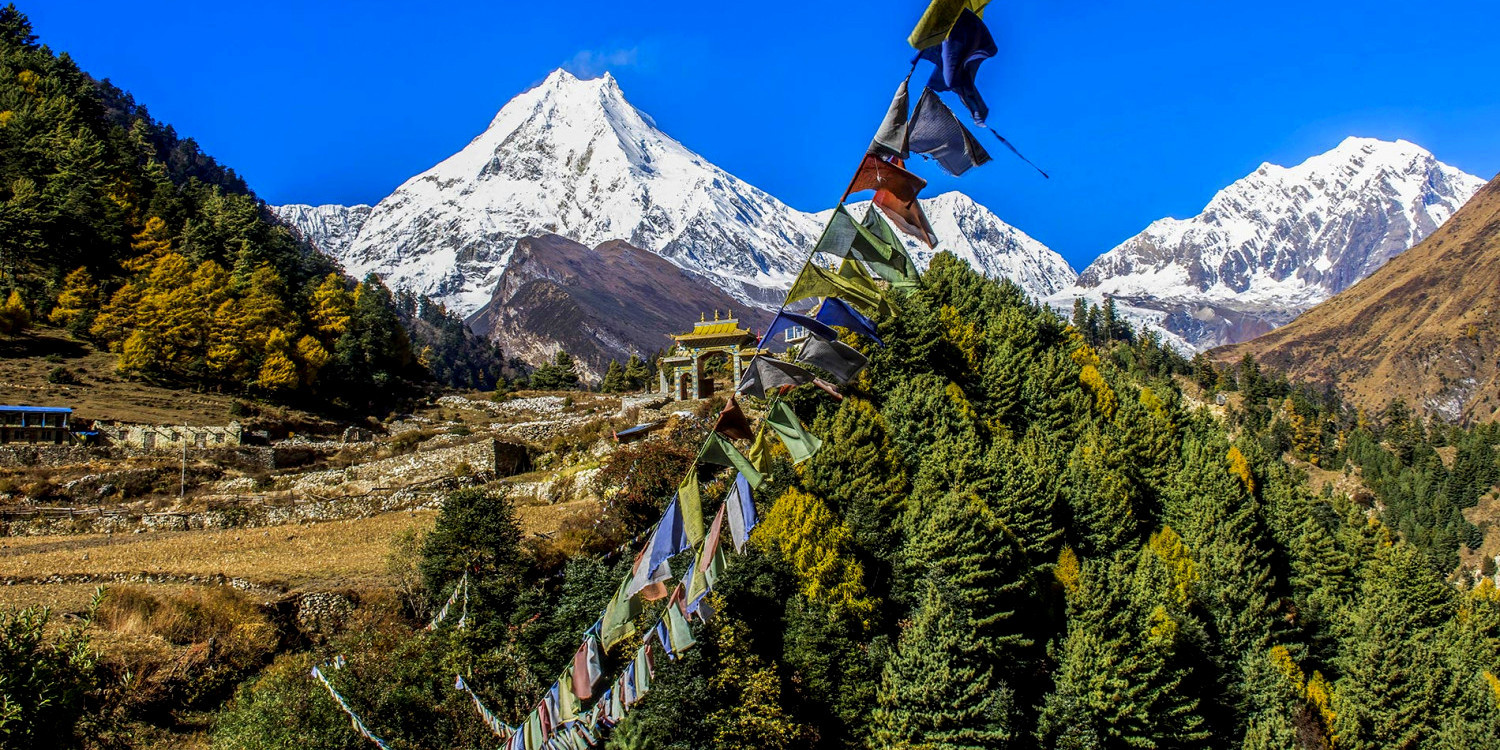
Overview
-
Duration: Typically 14 to 16 days
-
Starting Point: Soti Khola, after a drive from Kathmandu
-
Ending Point: Besisahar, which is also the starting point for the Annapurna Circuit
-
Difficulty: Challenging
-
Best Season: March to May and September to November, with October and November being particularly favored due to the stable weather and clear skies.
Route: The trek starts at Soti Khola, winding through lush forests, alpine meadows, and traditional villages in the Budhi Gandaki Valley. The trail becomes steeper and more rugged as it progresses, passing through Tibetan-influenced villages with ancient monasteries and rich culture. The high point of the trek is the crossing of the Larkya La Pass at 5,106 meters (16,752 feet), which offers spectacular views of Manaslu and other Himalayan giants. The trek concludes in Besisahar, which is also a gateway for the Annapurna region.
Highlights
-
Larkya La Pass: The highest point on the trek, providing breathtaking views across the Himalayas, including Himlung Himal, Cheo Himal, and Kang Guru.
-
Tsum Valley: An optional side trip that leads to a sacred Himalayan pilgrimage valley rich in ancient art, culture, and religion.
-
Cultural Experience: The trail goes through villages where daily life has remained unchanged for centuries. The region is predominantly Tibetan, offering a glimpse into authentic Buddhist culture and tradition.
-
Flora and Fauna: The Manaslu Conservation Area is home to diverse flora and fauna, including the elusive snow leopard and the Himalayan tahr.
The Manaslu Circuit Trek is an adventure that offers spectacular natural scenery and a deep cultural immersion unlike any other in Nepal. It remains a special trek for those looking to explore off-the-beaten-path trails and experience the raw beauty of the Himalayas.
Ghorepani Poon Hill Trek
The Ghorepani Poon Hill Trek is one of the most popular and accessible treks in the Annapurna region of Nepal, offering panoramic views of the majestic Himalayas, including Annapurna and Dhaulagiri ranges. Known for its relatively easy trail and the spectacular Himalayan vistas, it's especially famous for the sunrise views from Poon Hill, which are considered some of the most breathtaking in Nepal.
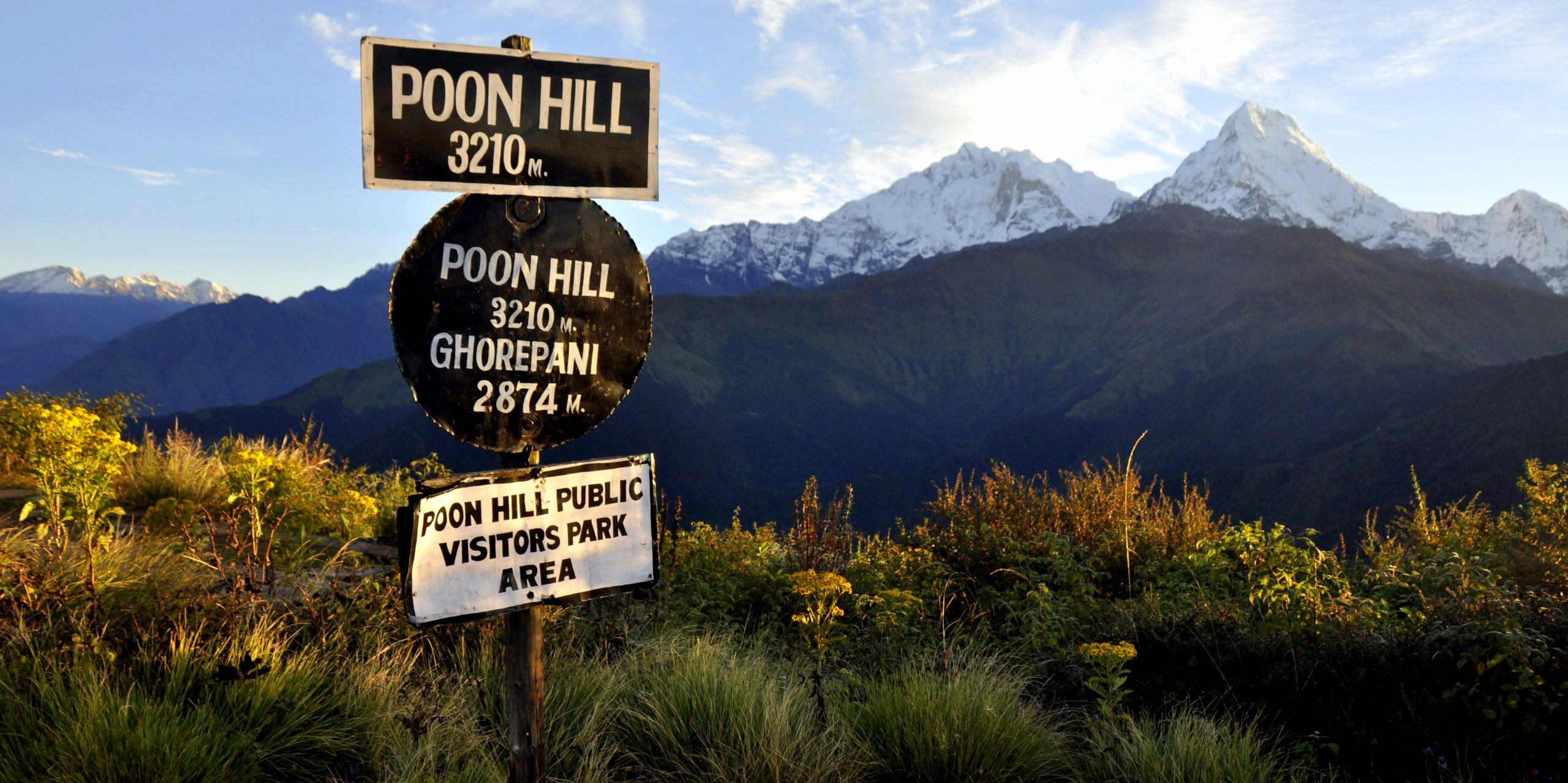
Overview
-
Duration: 4 to 5 days
-
Starting Point: Nayapul, a short drive from Pokhara
-
Ending Point: Nayapul
-
Difficulty: Easy to moderate
-
Best Season: March to May and September to November, with clear skies typically in the autumn months
Route: The trek begins at Nayapul, about an hour's drive from Pokhara. From here, trekkers walk through subtropical forests of oak, rhododendron, and magnolia, passing through small villages and terraced farm fields. The journey continues to Tikhedhunga and up to Ulleri, a challenging series of stone steps that test the endurance of trekkers. From Ulleri, the path leads to Ghorepani, a picturesque village nestled among the high Himalayan peaks. The highlight of the trek is an early morning hike to Poon Hill to witness a spectacular sunrise that illuminates the surrounding snow-capped mountains.
Highlights
-
Poon Hill: At an elevation of 3,210 meters (10,531 feet), Poon Hill offers one of the most spectacular mountainscapes on earth, with panoramic views of more than 20 high peaks.
-
Rhododendron Forests: Particularly beautiful during the spring months when the forests bloom with colorful rhododendrons.
-
Ghorepani Village: Known for its warm hospitality and the traditional lifestyle of the Gurung and Magar communities.
-
Cultural Interaction: The trail passes through several villages where trekkers can interact with the local communities and experience their rich cultural heritage.
The Ghorepani Poon Hill Trek is perfect for those looking to experience the beauty of the Nepal Himalayas without committing to the physical demands of higher altitude treks. It offers a memorable adventure with stunning natural beauty and cultural richness, making it a great choice for first-time trekkers in Nepal.
Mardi Himal Trek
The Mardi Himal Trek is a relatively new and less traveled route located in the Annapurna region of Nepal. This trek is a hidden gem that offers stunning views of the Annapurna range, including Machhapuchhre (Fishtail), Annapurna South, and Hiunchuli. It's an excellent choice for those looking to avoid the more crowded trails and immerse themselves in the tranquility and beauty of the Himalayas.
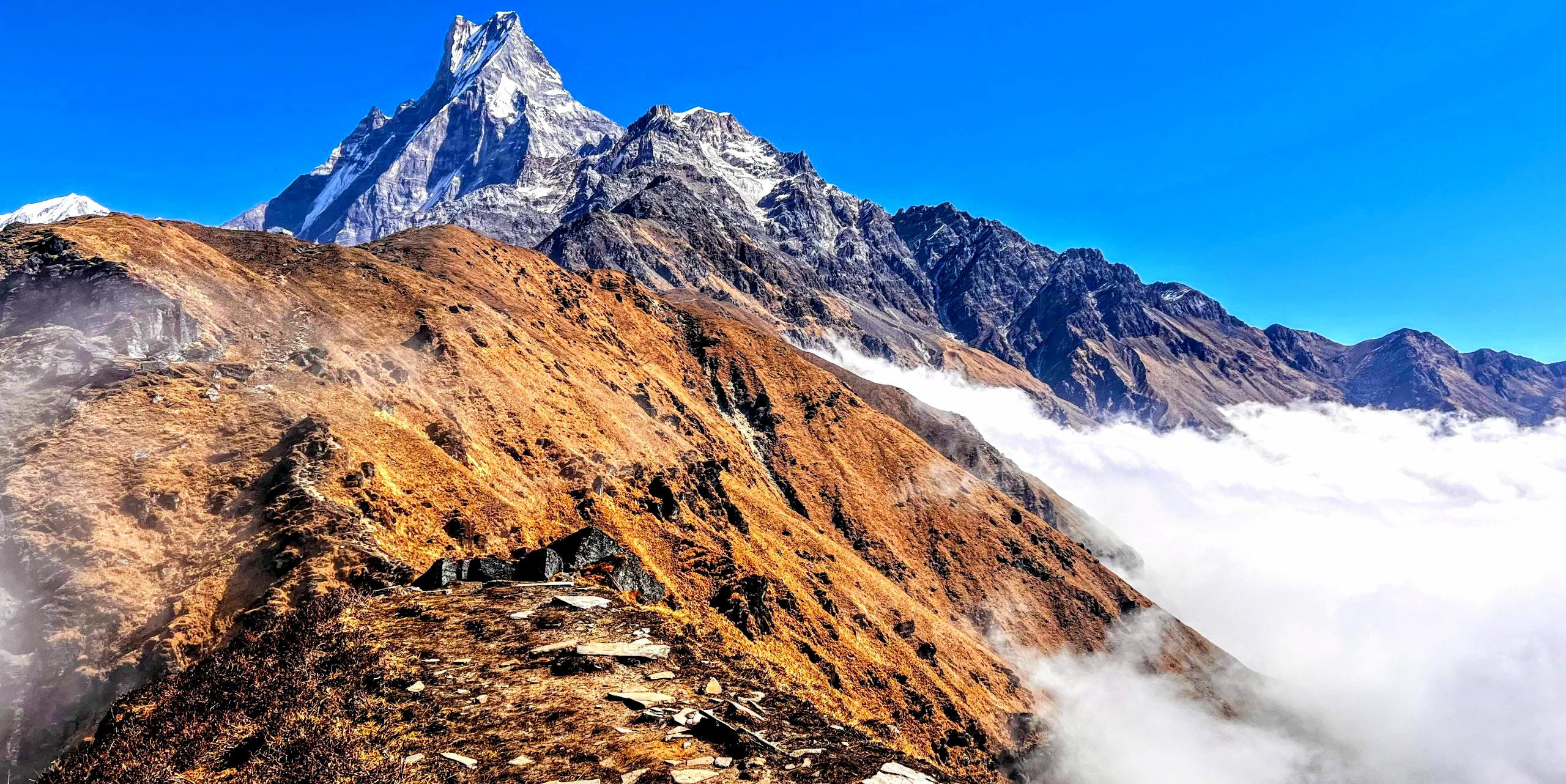
Overview
-
Duration: Typically 5 to 7 days
-
Starting Point: Kande, after a short drive from Pokhara
-
Ending Point: Siding village, from where you drive back to Pokhara
-
Difficulty: Moderate
-
Best Season: March to May and September to November, with autumn providing exceptionally clear weather and stable conditions
Route: The trek starts with a drive from Pokhara to Kande, which serves as the trailhead. From Kande, trekkers ascend to Australian Camp and then to Pothana and Deurali, which are traditional stops along the Annapurna Sanctuary route. The path diverts from the main trail and heads towards Forest Camp, also known as Kokar, and continues through dense rhododendron forests up to Low Camp and High Camp. The final ascent is to Mardi Himal Base Camp, which offers close-up views of the entire Annapurna range.
Highlights
-
Mardi Himal Base Camp: The ultimate destination of the trek, situated at around 4,500 meters (14,764 feet), where trekkers are rewarded with breathtaking views of snow-capped peaks.
-
Spectacular Views: The trek provides magnificent views of Machhapuchhre (Fishtail), Annapurna South, Hiunchuli, and Mardi Himal itself.
-
Varied Ecosystems: From lush forests to rugged high mountain landscapes, the trek traverses a variety of terrains that offer a comprehensive Himalayan trekking experience.
-
Seclusion: Being a less frequented trail, Mardi Himal offers a peaceful trekking experience, ideal for those looking to enjoy nature without the crowds.
The Mardi Himal Trek is perfect for adventurers seeking a quieter and more intimate encounter with the Himalayas. Its relatively short duration and moderate difficulty level make it an attractive option for those with limited time who still want to experience the grandeur of Nepal's mountain landscapes.
Tips for Best Autumn Treks in Nepal
Trekking in Nepal during the autumn season is widely considered ideal due to the clear skies, stable weather, and the post-monsoon freshness that enhances the beauty of the trails. Here are some tips to ensure you have the best possible experience on your autumn treks in Nepal:
-
Choose the Right Trek: Consider your fitness level, experience, and interests when selecting a trek. For instance, the Everest Base Camp and Annapurna Circuit are perfect for seasoned trekkers, while the Poon Hill or Langtang Valley treks are suitable for those looking for a less strenuous adventure.
-
Plan and Book in Advance: Autumn is a peak season for trekking in Nepal, so it’s crucial to plan and book your trip well in advance. This includes flights, accommodations, guides, and porters.
-
Acclimatize Properly: Take time to acclimatize to high altitudes, especially if you're trekking above 3,000 meters. Include acclimatization days in your itinerary to reduce the risk of altitude sickness.
-
Pack Appropriately: Layering is key in managing the varied temperatures you’ll encounter. Pack layers of breathable and moisture-wicking clothing, a warm jacket, and a waterproof outer layer.
-
Stay Hydrated: Drink plenty of water throughout your trek. Dehydration can exacerbate the effects of altitude sickness.
-
Hire a Guide and/or Porter: Hiring a local guide can enhance your trekking experience. Guides provide valuable insights into the local culture and landscapes and ensure you follow safe and suitable trails.
-
Travel Insurance: Make sure your travel insurance covers high-altitude trekking and includes provisions for medical emergencies and evacuation. This is crucial for remote and high-altitude treks where medical facilities are limited.
-
Respect Local Customs and Environment: Learn about and respect the local customs and traditions. Always ask permission before taking photographs of people.
-
Check the Weather: Stay informed about the weather conditions and be prepared for sudden changes. Although autumn generally offers stable weather, the mountains can be unpredictable.
-
Prepare Physically: Before embarking on a trek, engage in physical activities that improve your stamina, strength, and endurance. Cardiovascular exercises like running, cycling, and swimming are good preparatory workouts.
By following these tips, you can maximize your enjoyment and safety during your autumn trek in Nepal, making it a memorable and rewarding experience.
Trekking in Nepal during autumn is an exceptional experience, characterized by clear skies, stable weather, and vibrant landscapes. Whether you opt for the rigorous Everest Base Camp, the scenic Annapurna Circuit, or the culturally rich Langtang Valley, autumn is the perfect season to explore the natural and cultural beauty of the Himalayas. Proper planning, physical preparation, and respect for local customs and the environment are essential for a rewarding and memorable adventure. Autumn in Nepal offers not just a trek but a profound connection with nature and an insight into the vibrant spirit of its people.
FAQs for Best Autumn Treks in Nepal
Q: What is the best time to trek in Nepal during autumn?
A: The best months for autumn trekking in Nepal are October and November. During these months, the weather is stable, the skies are clear, and the views are spectacular.
Q: What are the most popular treks in Nepal for the autumn season?
A: The most popular autumn treks in Nepal include the Everest Base Camp Trek, Annapurna Circuit Trek, Langtang Valley Trek, Manaslu Circuit Trek, and the Ghorepani Poon Hill Trek.
Q: Do I need a guide for trekking in Nepal?
A: While not all treks require a guide, hiring one is highly recommended, especially for remote or challenging routes like the Everest Base Camp or Manaslu Circuit. Guides ensure safety, help with navigation, and provide insights into the local culture and environment.
Q: What permits do I need for trekking in Nepal?
A: Most treks in Nepal require a Trekkers' Information Management System (TIMS) card and a permit for the respective conservation area, such as the Annapurna Conservation Area Permit (ACAP) or the Sagarmatha National Park Permit for Everest region treks.
Q: How should I prepare for high-altitude trekking?
A: To prepare for high-altitude trekking, engage in cardiovascular exercises like running, swimming, or cycling several months before your trek. It’s also beneficial to include hikes that simulate the elevation gains and duration you will experience in Nepal.
Q: What should I pack for an autumn trek in Nepal?
A: Essential items include layered clothing, a waterproof jacket, sturdy trekking boots, a sleeping bag suitable for cold temperatures, a first aid kit, and sun protection. Also, pack a map, a compass, and a portable water filter.
Q: How do I deal with altitude sickness?
A: To mitigate the risk of altitude sickness, ascend slowly to allow your body to acclimatize, stay hydrated, and avoid alcohol and smoking. Recognize the symptoms early and descend to a lower altitude if they worsen.
Q: What kind of accommodation is available on the trekking routes?
A: Most trekking routes offer teahouse accommodations, providing basic rooms and communal dining. These teahouses offer a chance to enjoy local hospitality and traditional Nepali food.
Q: Are there any cultural considerations I should be aware of?
A: Respect local customs and traditions. Dress modestly, ask for permission before photographing people, and be considerate of local religious practices. Participating in or observing local festivals can greatly enrich your trekking experience.
Q: Can I trek independently in restricted areas like Manaslu?
A: Trekking in restricted areas such as Manaslu requires a permit, a guide, and generally a group of at least two trekkers. These regulations help preserve the ecological and cultural integrity of the region.
For the Nepal tour, please click here.
If you are looking for different kinds of Nepal Tours or Trekking Packages, feel free to contact us.
